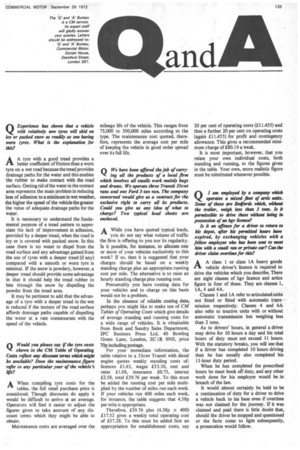Q Experience has shown that a vehicle with relatively new tyres
Page 415

If you've noticed an error in this article please click here to report it so we can fix it.
will skid on ice or packed snow as readily as one having worn tyres. What is the explanation for this?
AA tyre with a good tread provides a better coefficient of friction than a worn tyre on a wet road because the tread provides drainage paths for the water and this enables the rubber to make contact with the road surface. Getting rid of the water in the contact area represents the main problem in reducing loss of adhesion to a minimum in wet weather, the higher the speed of the vehicle the greater the value of adequate drainage paths for the water.
It is necessary to understand the fundamental purpose of a tread pattern to appreciate the lack of improvement in adhesion, provided by a deeper tread, when the road is icy or is covered with packed snow. In this case there is no water to dispel from the road surface and any advantage gained from the use of tyres with a deeper tread (if any) compared with a smooth or worn tyre is minimal. If the snow is powdery, however, a deeper tread should provide some advantage in that it should help the tread rubber to bite through the snow by dispelling the powder from the tread area.
It may be pertinent to add that the advanage of a tyre with a deeper tread in the wet is reduced if the texture of the road surface affords drainage paths capable of dispelling the water at a rate comensurate with the speed of the vehicle.
































































































































































































































































































































































































































































































































